Gender Inequality in the Film Industry (Hollywood): A Study
VerifiedAdded on 2021/05/12
|21
|6263
|249
Essay
AI Summary
This essay examines gender inequality in the Hollywood film industry, focusing on the portrayal of women in musical films. The introduction outlines the author's interest in the topic, the aim of the research, research questions, objectives, and significance. The literature review explores feminist theory, genre, representation, and related studies. The methodology chapter will clarify the research methods used in the dissertation. The analysis chapter will present the research analysis and observations. The conclusion will summarize the findings, including the history of the Hollywood film industry and the progression in musical films based on feminist theory. The study analyzes two musicals, "Gentlemen Prefer Blondes" and "Burlesque," to understand how female characters are represented and the impact of feminist theory on their empowerment. The research also investigates the roles of critical mass theory and critical actor theory in gender inequality and the persistent gender segregation in Hollywood, despite the industry's success.
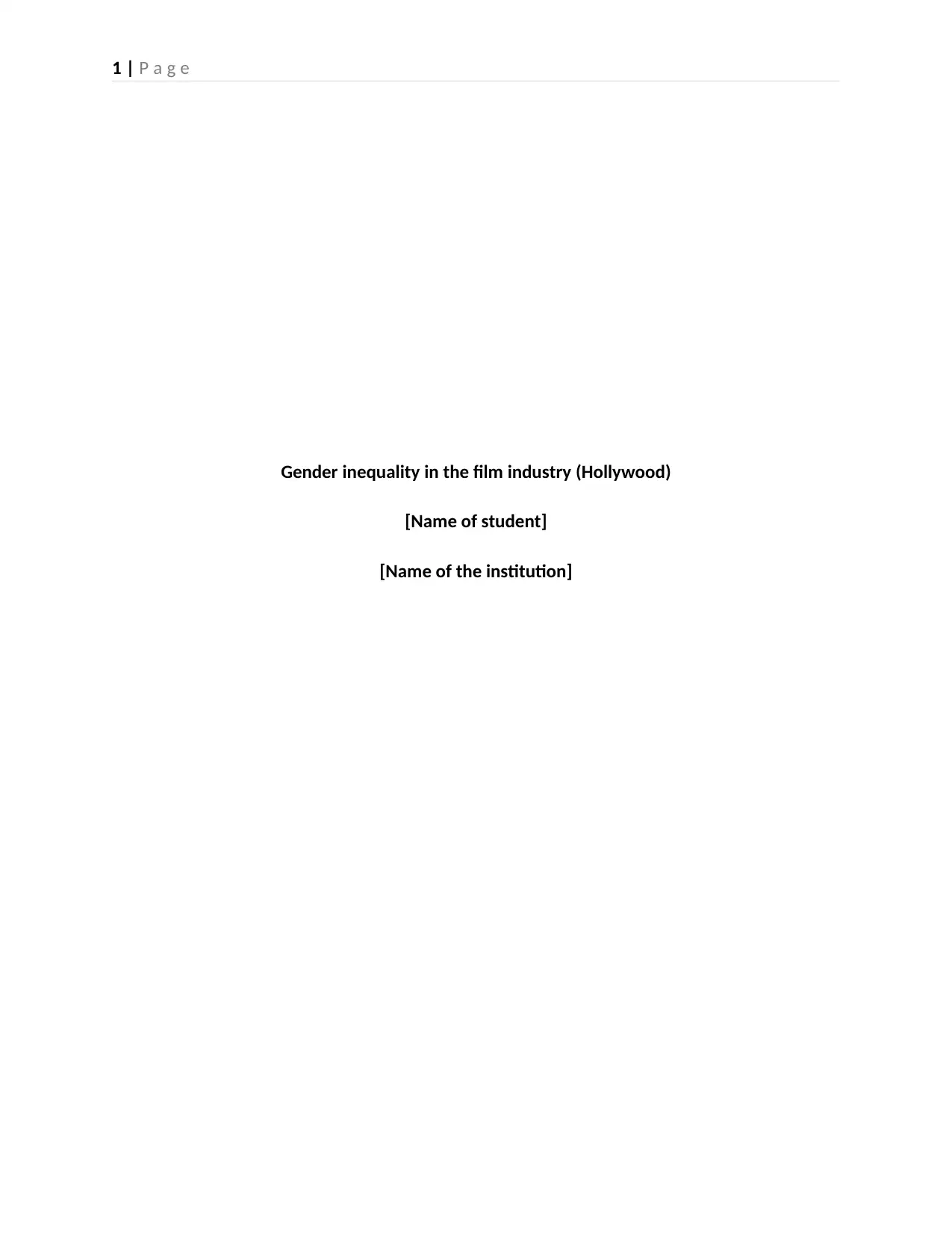
1 | P a g e
Gender inequality in the film industry (Hollywood)
[Name of student]
[Name of the institution]
Gender inequality in the film industry (Hollywood)
[Name of student]
[Name of the institution]
Paraphrase This Document
Need a fresh take? Get an instant paraphrase of this document with our AI Paraphraser
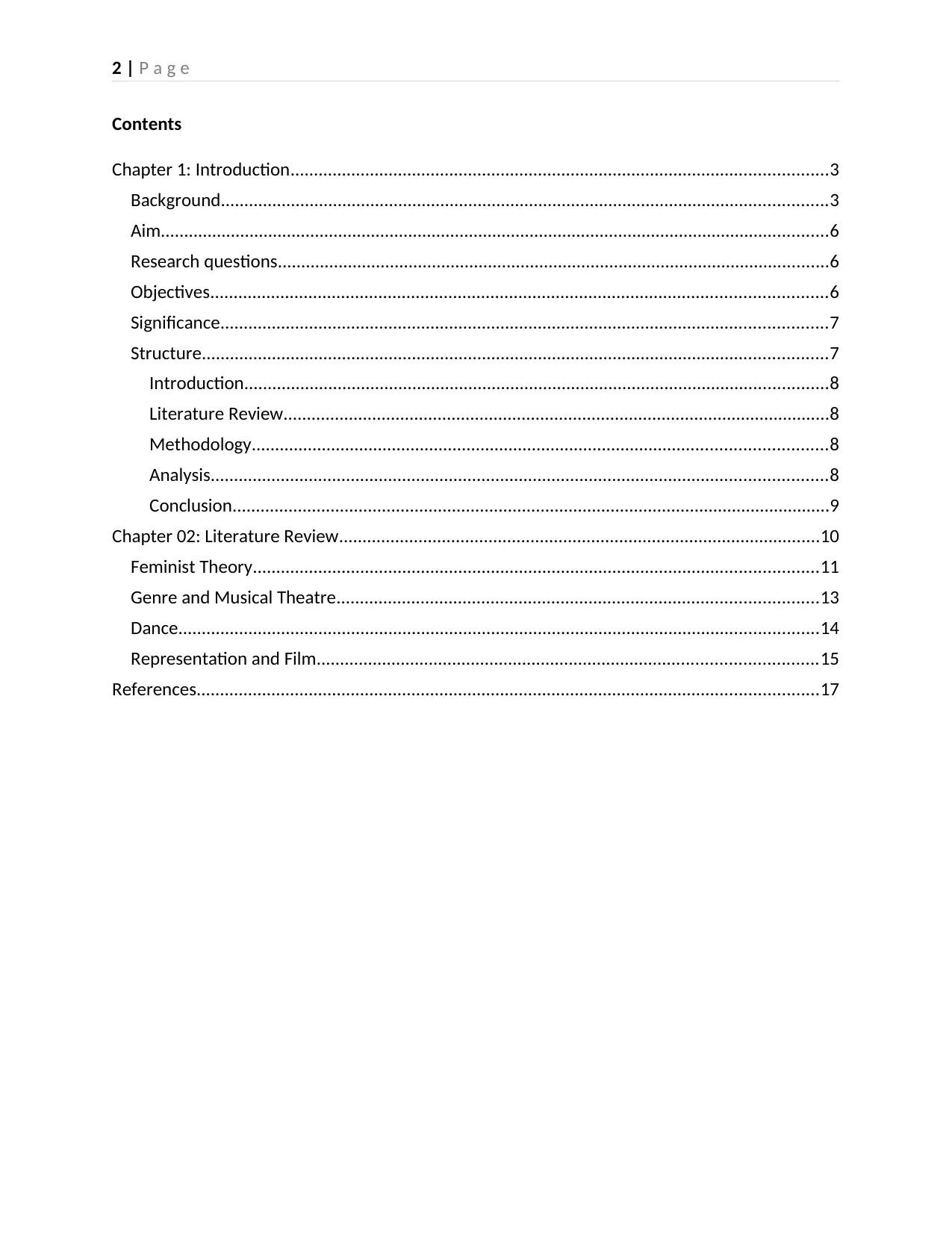
2 | P a g e
Contents
Chapter 1: Introduction...................................................................................................................3
Background..................................................................................................................................3
Aim...............................................................................................................................................6
Research questions......................................................................................................................6
Objectives....................................................................................................................................6
Significance..................................................................................................................................7
Structure......................................................................................................................................7
Introduction.............................................................................................................................8
Literature Review.....................................................................................................................8
Methodology...........................................................................................................................8
Analysis....................................................................................................................................8
Conclusion................................................................................................................................9
Chapter 02: Literature Review.......................................................................................................10
Feminist Theory.........................................................................................................................11
Genre and Musical Theatre.......................................................................................................13
Dance.........................................................................................................................................14
Representation and Film...........................................................................................................15
References.....................................................................................................................................17
Contents
Chapter 1: Introduction...................................................................................................................3
Background..................................................................................................................................3
Aim...............................................................................................................................................6
Research questions......................................................................................................................6
Objectives....................................................................................................................................6
Significance..................................................................................................................................7
Structure......................................................................................................................................7
Introduction.............................................................................................................................8
Literature Review.....................................................................................................................8
Methodology...........................................................................................................................8
Analysis....................................................................................................................................8
Conclusion................................................................................................................................9
Chapter 02: Literature Review.......................................................................................................10
Feminist Theory.........................................................................................................................11
Genre and Musical Theatre.......................................................................................................13
Dance.........................................................................................................................................14
Representation and Film...........................................................................................................15
References.....................................................................................................................................17
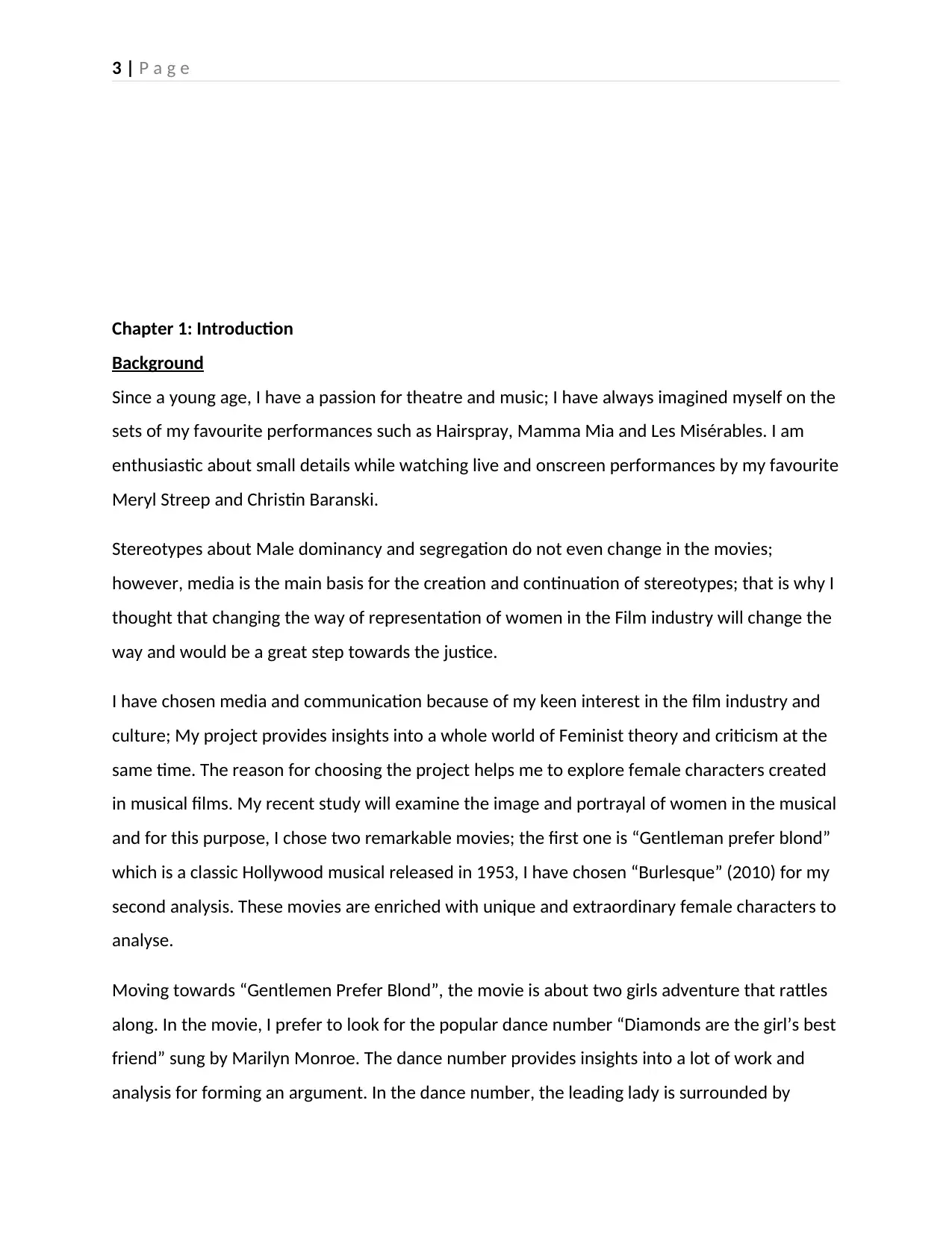
3 | P a g e
Chapter 1: Introduction
Background
Since a young age, I have a passion for theatre and music; I have always imagined myself on the
sets of my favourite performances such as Hairspray, Mamma Mia and Les Misérables. I am
enthusiastic about small details while watching live and onscreen performances by my favourite
Meryl Streep and Christin Baranski.
Stereotypes about Male dominancy and segregation do not even change in the movies;
however, media is the main basis for the creation and continuation of stereotypes; that is why I
thought that changing the way of representation of women in the Film industry will change the
way and would be a great step towards the justice.
I have chosen media and communication because of my keen interest in the film industry and
culture; My project provides insights into a whole world of Feminist theory and criticism at the
same time. The reason for choosing the project helps me to explore female characters created
in musical films. My recent study will examine the image and portrayal of women in the musical
and for this purpose, I chose two remarkable movies; the first one is “Gentleman prefer blond”
which is a classic Hollywood musical released in 1953, I have chosen “Burlesque” (2010) for my
second analysis. These movies are enriched with unique and extraordinary female characters to
analyse.
Moving towards “Gentlemen Prefer Blond”, the movie is about two girls adventure that rattles
along. In the movie, I prefer to look for the popular dance number “Diamonds are the girl’s best
friend” sung by Marilyn Monroe. The dance number provides insights into a lot of work and
analysis for forming an argument. In the dance number, the leading lady is surrounded by
Chapter 1: Introduction
Background
Since a young age, I have a passion for theatre and music; I have always imagined myself on the
sets of my favourite performances such as Hairspray, Mamma Mia and Les Misérables. I am
enthusiastic about small details while watching live and onscreen performances by my favourite
Meryl Streep and Christin Baranski.
Stereotypes about Male dominancy and segregation do not even change in the movies;
however, media is the main basis for the creation and continuation of stereotypes; that is why I
thought that changing the way of representation of women in the Film industry will change the
way and would be a great step towards the justice.
I have chosen media and communication because of my keen interest in the film industry and
culture; My project provides insights into a whole world of Feminist theory and criticism at the
same time. The reason for choosing the project helps me to explore female characters created
in musical films. My recent study will examine the image and portrayal of women in the musical
and for this purpose, I chose two remarkable movies; the first one is “Gentleman prefer blond”
which is a classic Hollywood musical released in 1953, I have chosen “Burlesque” (2010) for my
second analysis. These movies are enriched with unique and extraordinary female characters to
analyse.
Moving towards “Gentlemen Prefer Blond”, the movie is about two girls adventure that rattles
along. In the movie, I prefer to look for the popular dance number “Diamonds are the girl’s best
friend” sung by Marilyn Monroe. The dance number provides insights into a lot of work and
analysis for forming an argument. In the dance number, the leading lady is surrounded by
⊘ This is a preview!⊘
Do you want full access?
Subscribe today to unlock all pages.

Trusted by 1+ million students worldwide
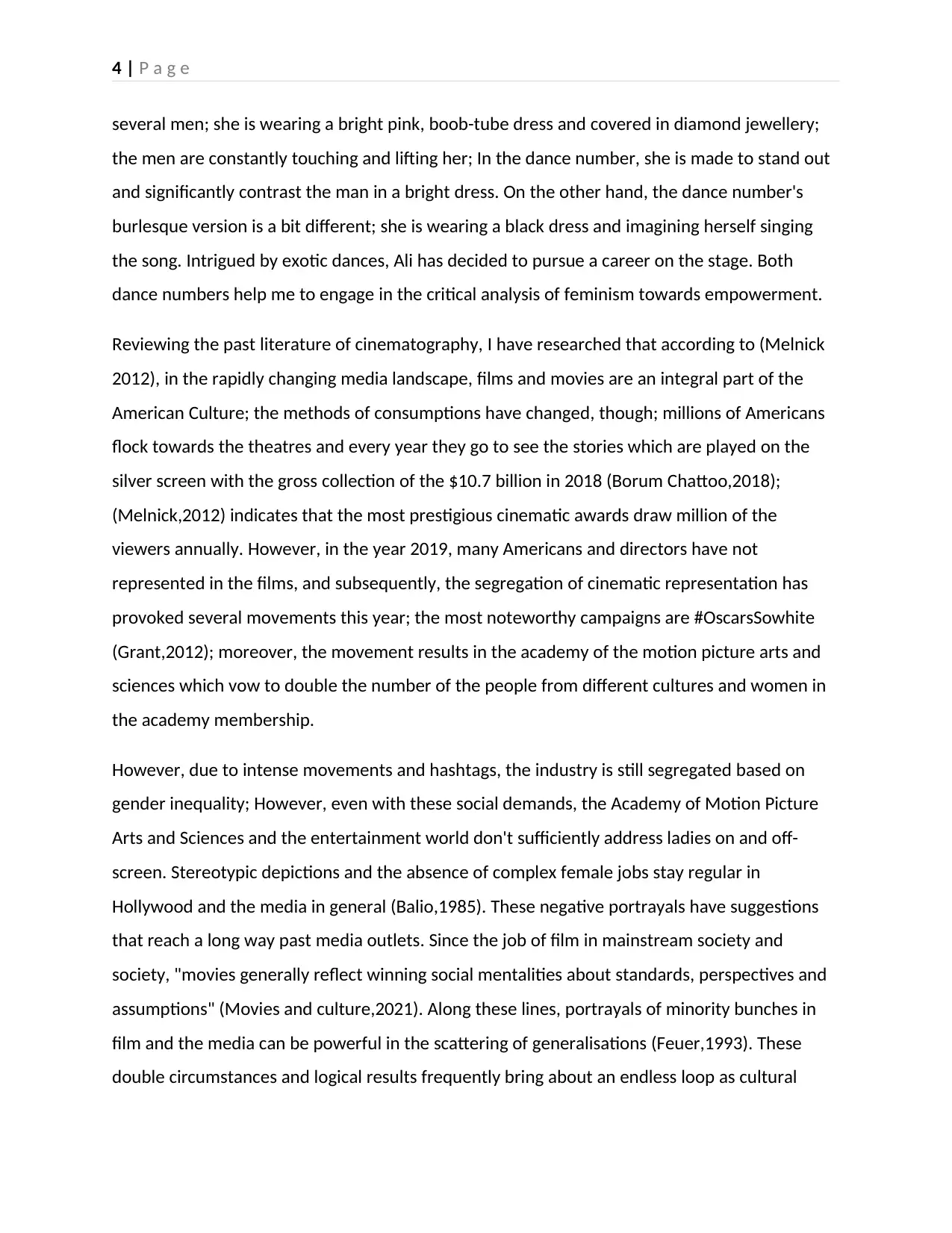
4 | P a g e
several men; she is wearing a bright pink, boob-tube dress and covered in diamond jewellery;
the men are constantly touching and lifting her; In the dance number, she is made to stand out
and significantly contrast the man in a bright dress. On the other hand, the dance number's
burlesque version is a bit different; she is wearing a black dress and imagining herself singing
the song. Intrigued by exotic dances, Ali has decided to pursue a career on the stage. Both
dance numbers help me to engage in the critical analysis of feminism towards empowerment.
Reviewing the past literature of cinematography, I have researched that according to (Melnick
2012), in the rapidly changing media landscape, films and movies are an integral part of the
American Culture; the methods of consumptions have changed, though; millions of Americans
flock towards the theatres and every year they go to see the stories which are played on the
silver screen with the gross collection of the $10.7 billion in 2018 (Borum Chattoo,2018);
(Melnick,2012) indicates that the most prestigious cinematic awards draw million of the
viewers annually. However, in the year 2019, many Americans and directors have not
represented in the films, and subsequently, the segregation of cinematic representation has
provoked several movements this year; the most noteworthy campaigns are #OscarsSowhite
(Grant,2012); moreover, the movement results in the academy of the motion picture arts and
sciences which vow to double the number of the people from different cultures and women in
the academy membership.
However, due to intense movements and hashtags, the industry is still segregated based on
gender inequality; However, even with these social demands, the Academy of Motion Picture
Arts and Sciences and the entertainment world don't sufficiently address ladies on and off-
screen. Stereotypic depictions and the absence of complex female jobs stay regular in
Hollywood and the media in general (Balio,1985). These negative portrayals have suggestions
that reach a long way past media outlets. Since the job of film in mainstream society and
society, "movies generally reflect winning social mentalities about standards, perspectives and
assumptions" (Movies and culture,2021). Along these lines, portrayals of minority bunches in
film and the media can be powerful in the scattering of generalisations (Feuer,1993). These
double circumstances and logical results frequently bring about an endless loop as cultural
several men; she is wearing a bright pink, boob-tube dress and covered in diamond jewellery;
the men are constantly touching and lifting her; In the dance number, she is made to stand out
and significantly contrast the man in a bright dress. On the other hand, the dance number's
burlesque version is a bit different; she is wearing a black dress and imagining herself singing
the song. Intrigued by exotic dances, Ali has decided to pursue a career on the stage. Both
dance numbers help me to engage in the critical analysis of feminism towards empowerment.
Reviewing the past literature of cinematography, I have researched that according to (Melnick
2012), in the rapidly changing media landscape, films and movies are an integral part of the
American Culture; the methods of consumptions have changed, though; millions of Americans
flock towards the theatres and every year they go to see the stories which are played on the
silver screen with the gross collection of the $10.7 billion in 2018 (Borum Chattoo,2018);
(Melnick,2012) indicates that the most prestigious cinematic awards draw million of the
viewers annually. However, in the year 2019, many Americans and directors have not
represented in the films, and subsequently, the segregation of cinematic representation has
provoked several movements this year; the most noteworthy campaigns are #OscarsSowhite
(Grant,2012); moreover, the movement results in the academy of the motion picture arts and
sciences which vow to double the number of the people from different cultures and women in
the academy membership.
However, due to intense movements and hashtags, the industry is still segregated based on
gender inequality; However, even with these social demands, the Academy of Motion Picture
Arts and Sciences and the entertainment world don't sufficiently address ladies on and off-
screen. Stereotypic depictions and the absence of complex female jobs stay regular in
Hollywood and the media in general (Balio,1985). These negative portrayals have suggestions
that reach a long way past media outlets. Since the job of film in mainstream society and
society, "movies generally reflect winning social mentalities about standards, perspectives and
assumptions" (Movies and culture,2021). Along these lines, portrayals of minority bunches in
film and the media can be powerful in the scattering of generalisations (Feuer,1993). These
double circumstances and logical results frequently bring about an endless loop as cultural
Paraphrase This Document
Need a fresh take? Get an instant paraphrase of this document with our AI Paraphraser
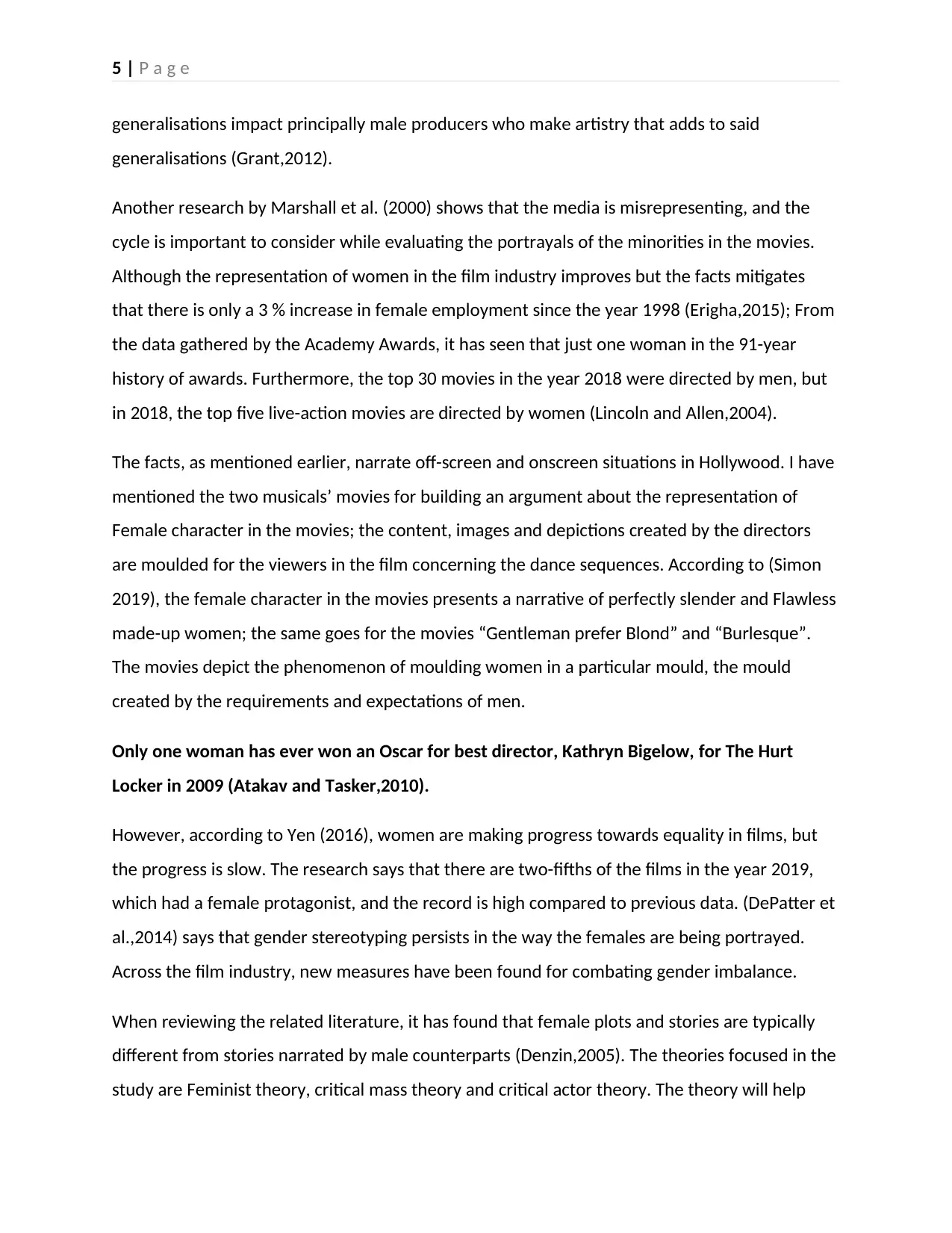
5 | P a g e
generalisations impact principally male producers who make artistry that adds to said
generalisations (Grant,2012).
Another research by Marshall et al. (2000) shows that the media is misrepresenting, and the
cycle is important to consider while evaluating the portrayals of the minorities in the movies.
Although the representation of women in the film industry improves but the facts mitigates
that there is only a 3 % increase in female employment since the year 1998 (Erigha,2015); From
the data gathered by the Academy Awards, it has seen that just one woman in the 91-year
history of awards. Furthermore, the top 30 movies in the year 2018 were directed by men, but
in 2018, the top five live-action movies are directed by women (Lincoln and Allen,2004).
The facts, as mentioned earlier, narrate off-screen and onscreen situations in Hollywood. I have
mentioned the two musicals’ movies for building an argument about the representation of
Female character in the movies; the content, images and depictions created by the directors
are moulded for the viewers in the film concerning the dance sequences. According to (Simon
2019), the female character in the movies presents a narrative of perfectly slender and Flawless
made-up women; the same goes for the movies “Gentleman prefer Blond” and “Burlesque”.
The movies depict the phenomenon of moulding women in a particular mould, the mould
created by the requirements and expectations of men.
Only one woman has ever won an Oscar for best director, Kathryn Bigelow, for The Hurt
Locker in 2009 (Atakav and Tasker,2010).
However, according to Yen (2016), women are making progress towards equality in films, but
the progress is slow. The research says that there are two-fifths of the films in the year 2019,
which had a female protagonist, and the record is high compared to previous data. (DePatter et
al.,2014) says that gender stereotyping persists in the way the females are being portrayed.
Across the film industry, new measures have been found for combating gender imbalance.
When reviewing the related literature, it has found that female plots and stories are typically
different from stories narrated by male counterparts (Denzin,2005). The theories focused in the
study are Feminist theory, critical mass theory and critical actor theory. The theory will help
generalisations impact principally male producers who make artistry that adds to said
generalisations (Grant,2012).
Another research by Marshall et al. (2000) shows that the media is misrepresenting, and the
cycle is important to consider while evaluating the portrayals of the minorities in the movies.
Although the representation of women in the film industry improves but the facts mitigates
that there is only a 3 % increase in female employment since the year 1998 (Erigha,2015); From
the data gathered by the Academy Awards, it has seen that just one woman in the 91-year
history of awards. Furthermore, the top 30 movies in the year 2018 were directed by men, but
in 2018, the top five live-action movies are directed by women (Lincoln and Allen,2004).
The facts, as mentioned earlier, narrate off-screen and onscreen situations in Hollywood. I have
mentioned the two musicals’ movies for building an argument about the representation of
Female character in the movies; the content, images and depictions created by the directors
are moulded for the viewers in the film concerning the dance sequences. According to (Simon
2019), the female character in the movies presents a narrative of perfectly slender and Flawless
made-up women; the same goes for the movies “Gentleman prefer Blond” and “Burlesque”.
The movies depict the phenomenon of moulding women in a particular mould, the mould
created by the requirements and expectations of men.
Only one woman has ever won an Oscar for best director, Kathryn Bigelow, for The Hurt
Locker in 2009 (Atakav and Tasker,2010).
However, according to Yen (2016), women are making progress towards equality in films, but
the progress is slow. The research says that there are two-fifths of the films in the year 2019,
which had a female protagonist, and the record is high compared to previous data. (DePatter et
al.,2014) says that gender stereotyping persists in the way the females are being portrayed.
Across the film industry, new measures have been found for combating gender imbalance.
When reviewing the related literature, it has found that female plots and stories are typically
different from stories narrated by male counterparts (Denzin,2005). The theories focused in the
study are Feminist theory, critical mass theory and critical actor theory. The theory will help
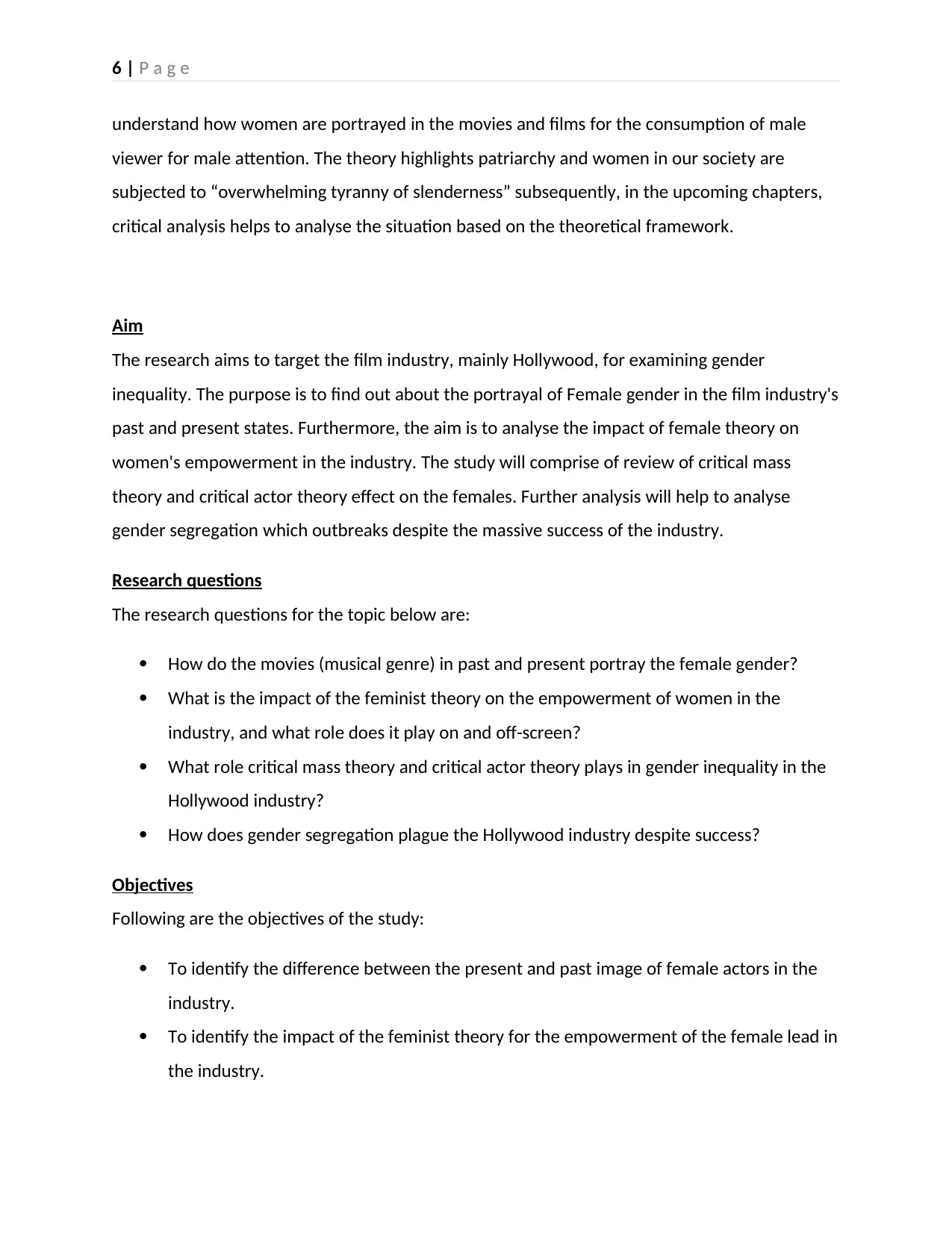
6 | P a g e
understand how women are portrayed in the movies and films for the consumption of male
viewer for male attention. The theory highlights patriarchy and women in our society are
subjected to “overwhelming tyranny of slenderness” subsequently, in the upcoming chapters,
critical analysis helps to analyse the situation based on the theoretical framework.
Aim
The research aims to target the film industry, mainly Hollywood, for examining gender
inequality. The purpose is to find out about the portrayal of Female gender in the film industry's
past and present states. Furthermore, the aim is to analyse the impact of female theory on
women's empowerment in the industry. The study will comprise of review of critical mass
theory and critical actor theory effect on the females. Further analysis will help to analyse
gender segregation which outbreaks despite the massive success of the industry.
Research questions
The research questions for the topic below are:
How do the movies (musical genre) in past and present portray the female gender?
What is the impact of the feminist theory on the empowerment of women in the
industry, and what role does it play on and off-screen?
What role critical mass theory and critical actor theory plays in gender inequality in the
Hollywood industry?
How does gender segregation plague the Hollywood industry despite success?
Objectives
Following are the objectives of the study:
To identify the difference between the present and past image of female actors in the
industry.
To identify the impact of the feminist theory for the empowerment of the female lead in
the industry.
understand how women are portrayed in the movies and films for the consumption of male
viewer for male attention. The theory highlights patriarchy and women in our society are
subjected to “overwhelming tyranny of slenderness” subsequently, in the upcoming chapters,
critical analysis helps to analyse the situation based on the theoretical framework.
Aim
The research aims to target the film industry, mainly Hollywood, for examining gender
inequality. The purpose is to find out about the portrayal of Female gender in the film industry's
past and present states. Furthermore, the aim is to analyse the impact of female theory on
women's empowerment in the industry. The study will comprise of review of critical mass
theory and critical actor theory effect on the females. Further analysis will help to analyse
gender segregation which outbreaks despite the massive success of the industry.
Research questions
The research questions for the topic below are:
How do the movies (musical genre) in past and present portray the female gender?
What is the impact of the feminist theory on the empowerment of women in the
industry, and what role does it play on and off-screen?
What role critical mass theory and critical actor theory plays in gender inequality in the
Hollywood industry?
How does gender segregation plague the Hollywood industry despite success?
Objectives
Following are the objectives of the study:
To identify the difference between the present and past image of female actors in the
industry.
To identify the impact of the feminist theory for the empowerment of the female lead in
the industry.
⊘ This is a preview!⊘
Do you want full access?
Subscribe today to unlock all pages.

Trusted by 1+ million students worldwide
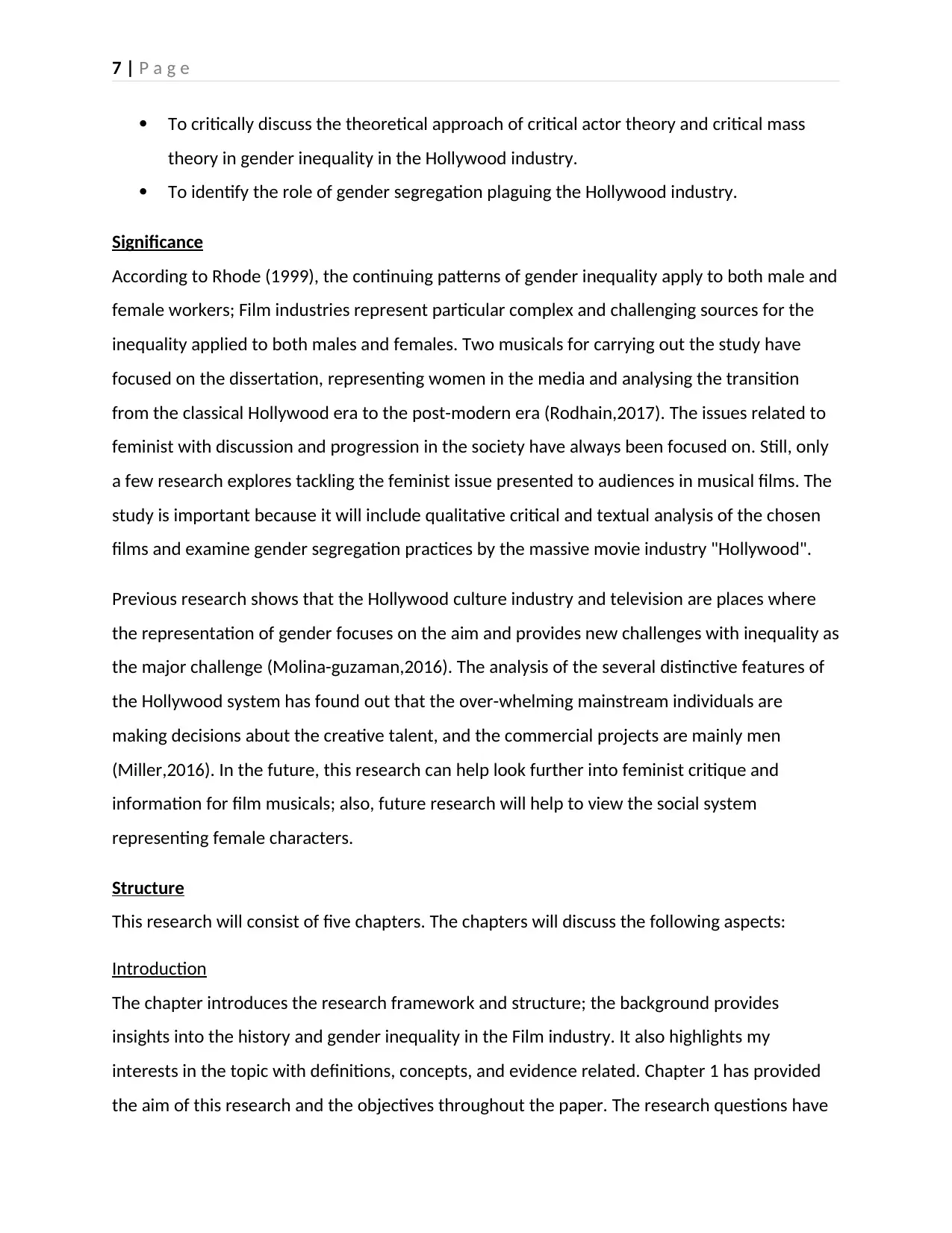
7 | P a g e
To critically discuss the theoretical approach of critical actor theory and critical mass
theory in gender inequality in the Hollywood industry.
To identify the role of gender segregation plaguing the Hollywood industry.
Significance
According to Rhode (1999), the continuing patterns of gender inequality apply to both male and
female workers; Film industries represent particular complex and challenging sources for the
inequality applied to both males and females. Two musicals for carrying out the study have
focused on the dissertation, representing women in the media and analysing the transition
from the classical Hollywood era to the post-modern era (Rodhain,2017). The issues related to
feminist with discussion and progression in the society have always been focused on. Still, only
a few research explores tackling the feminist issue presented to audiences in musical films. The
study is important because it will include qualitative critical and textual analysis of the chosen
films and examine gender segregation practices by the massive movie industry "Hollywood".
Previous research shows that the Hollywood culture industry and television are places where
the representation of gender focuses on the aim and provides new challenges with inequality as
the major challenge (Molina-guzaman,2016). The analysis of the several distinctive features of
the Hollywood system has found out that the over-whelming mainstream individuals are
making decisions about the creative talent, and the commercial projects are mainly men
(Miller,2016). In the future, this research can help look further into feminist critique and
information for film musicals; also, future research will help to view the social system
representing female characters.
Structure
This research will consist of five chapters. The chapters will discuss the following aspects:
Introduction
The chapter introduces the research framework and structure; the background provides
insights into the history and gender inequality in the Film industry. It also highlights my
interests in the topic with definitions, concepts, and evidence related. Chapter 1 has provided
the aim of this research and the objectives throughout the paper. The research questions have
To critically discuss the theoretical approach of critical actor theory and critical mass
theory in gender inequality in the Hollywood industry.
To identify the role of gender segregation plaguing the Hollywood industry.
Significance
According to Rhode (1999), the continuing patterns of gender inequality apply to both male and
female workers; Film industries represent particular complex and challenging sources for the
inequality applied to both males and females. Two musicals for carrying out the study have
focused on the dissertation, representing women in the media and analysing the transition
from the classical Hollywood era to the post-modern era (Rodhain,2017). The issues related to
feminist with discussion and progression in the society have always been focused on. Still, only
a few research explores tackling the feminist issue presented to audiences in musical films. The
study is important because it will include qualitative critical and textual analysis of the chosen
films and examine gender segregation practices by the massive movie industry "Hollywood".
Previous research shows that the Hollywood culture industry and television are places where
the representation of gender focuses on the aim and provides new challenges with inequality as
the major challenge (Molina-guzaman,2016). The analysis of the several distinctive features of
the Hollywood system has found out that the over-whelming mainstream individuals are
making decisions about the creative talent, and the commercial projects are mainly men
(Miller,2016). In the future, this research can help look further into feminist critique and
information for film musicals; also, future research will help to view the social system
representing female characters.
Structure
This research will consist of five chapters. The chapters will discuss the following aspects:
Introduction
The chapter introduces the research framework and structure; the background provides
insights into the history and gender inequality in the Film industry. It also highlights my
interests in the topic with definitions, concepts, and evidence related. Chapter 1 has provided
the aim of this research and the objectives throughout the paper. The research questions have
Paraphrase This Document
Need a fresh take? Get an instant paraphrase of this document with our AI Paraphraser
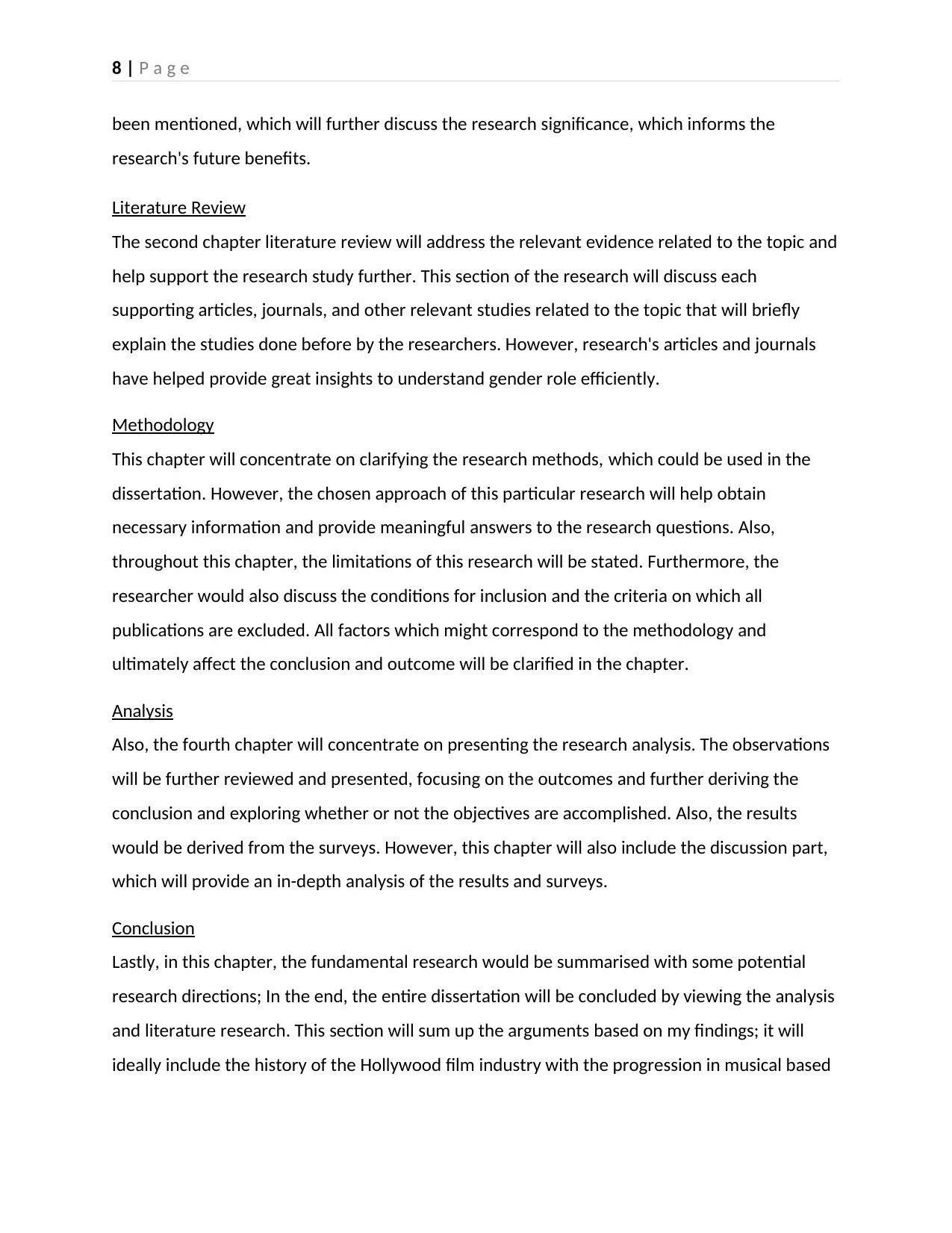
8 | P a g e
been mentioned, which will further discuss the research significance, which informs the
research's future benefits.
Literature Review
The second chapter literature review will address the relevant evidence related to the topic and
help support the research study further. This section of the research will discuss each
supporting articles, journals, and other relevant studies related to the topic that will briefly
explain the studies done before by the researchers. However, research's articles and journals
have helped provide great insights to understand gender role efficiently.
Methodology
This chapter will concentrate on clarifying the research methods, which could be used in the
dissertation. However, the chosen approach of this particular research will help obtain
necessary information and provide meaningful answers to the research questions. Also,
throughout this chapter, the limitations of this research will be stated. Furthermore, the
researcher would also discuss the conditions for inclusion and the criteria on which all
publications are excluded. All factors which might correspond to the methodology and
ultimately affect the conclusion and outcome will be clarified in the chapter.
Analysis
Also, the fourth chapter will concentrate on presenting the research analysis. The observations
will be further reviewed and presented, focusing on the outcomes and further deriving the
conclusion and exploring whether or not the objectives are accomplished. Also, the results
would be derived from the surveys. However, this chapter will also include the discussion part,
which will provide an in-depth analysis of the results and surveys.
Conclusion
Lastly, in this chapter, the fundamental research would be summarised with some potential
research directions; In the end, the entire dissertation will be concluded by viewing the analysis
and literature research. This section will sum up the arguments based on my findings; it will
ideally include the history of the Hollywood film industry with the progression in musical based
been mentioned, which will further discuss the research significance, which informs the
research's future benefits.
Literature Review
The second chapter literature review will address the relevant evidence related to the topic and
help support the research study further. This section of the research will discuss each
supporting articles, journals, and other relevant studies related to the topic that will briefly
explain the studies done before by the researchers. However, research's articles and journals
have helped provide great insights to understand gender role efficiently.
Methodology
This chapter will concentrate on clarifying the research methods, which could be used in the
dissertation. However, the chosen approach of this particular research will help obtain
necessary information and provide meaningful answers to the research questions. Also,
throughout this chapter, the limitations of this research will be stated. Furthermore, the
researcher would also discuss the conditions for inclusion and the criteria on which all
publications are excluded. All factors which might correspond to the methodology and
ultimately affect the conclusion and outcome will be clarified in the chapter.
Analysis
Also, the fourth chapter will concentrate on presenting the research analysis. The observations
will be further reviewed and presented, focusing on the outcomes and further deriving the
conclusion and exploring whether or not the objectives are accomplished. Also, the results
would be derived from the surveys. However, this chapter will also include the discussion part,
which will provide an in-depth analysis of the results and surveys.
Conclusion
Lastly, in this chapter, the fundamental research would be summarised with some potential
research directions; In the end, the entire dissertation will be concluded by viewing the analysis
and literature research. This section will sum up the arguments based on my findings; it will
ideally include the history of the Hollywood film industry with the progression in musical based

9 | P a g e
on feminist theory, representing the women realistically and fairly based on their acting skills
than beauty and sexualism.
on feminist theory, representing the women realistically and fairly based on their acting skills
than beauty and sexualism.
⊘ This is a preview!⊘
Do you want full access?
Subscribe today to unlock all pages.

Trusted by 1+ million students worldwide
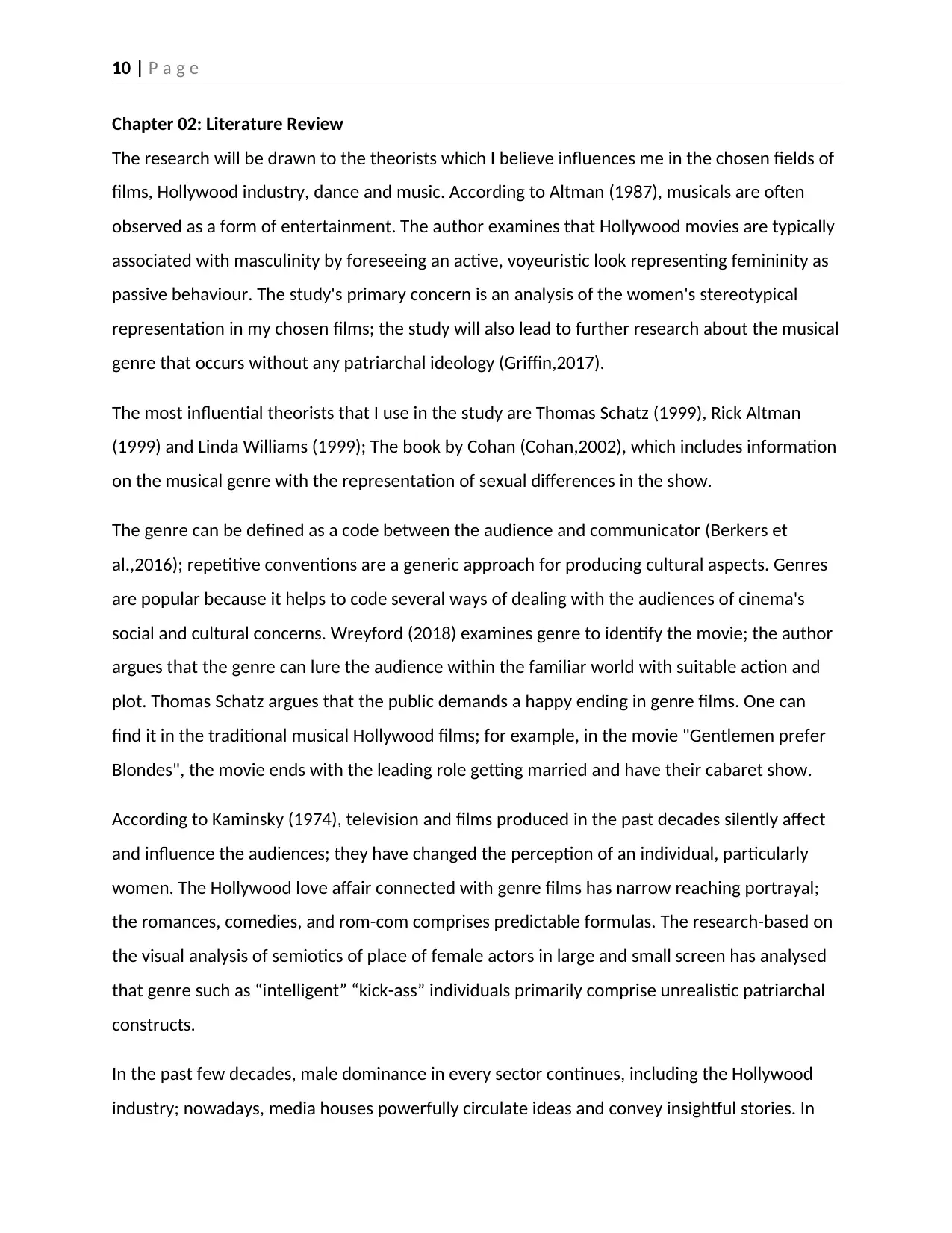
10 | P a g e
Chapter 02: Literature Review
The research will be drawn to the theorists which I believe influences me in the chosen fields of
films, Hollywood industry, dance and music. According to Altman (1987), musicals are often
observed as a form of entertainment. The author examines that Hollywood movies are typically
associated with masculinity by foreseeing an active, voyeuristic look representing femininity as
passive behaviour. The study's primary concern is an analysis of the women's stereotypical
representation in my chosen films; the study will also lead to further research about the musical
genre that occurs without any patriarchal ideology (Griffin,2017).
The most influential theorists that I use in the study are Thomas Schatz (1999), Rick Altman
(1999) and Linda Williams (1999); The book by Cohan (Cohan,2002), which includes information
on the musical genre with the representation of sexual differences in the show.
The genre can be defined as a code between the audience and communicator (Berkers et
al.,2016); repetitive conventions are a generic approach for producing cultural aspects. Genres
are popular because it helps to code several ways of dealing with the audiences of cinema's
social and cultural concerns. Wreyford (2018) examines genre to identify the movie; the author
argues that the genre can lure the audience within the familiar world with suitable action and
plot. Thomas Schatz argues that the public demands a happy ending in genre films. One can
find it in the traditional musical Hollywood films; for example, in the movie "Gentlemen prefer
Blondes", the movie ends with the leading role getting married and have their cabaret show.
According to Kaminsky (1974), television and films produced in the past decades silently affect
and influence the audiences; they have changed the perception of an individual, particularly
women. The Hollywood love affair connected with genre films has narrow reaching portrayal;
the romances, comedies, and rom-com comprises predictable formulas. The research-based on
the visual analysis of semiotics of place of female actors in large and small screen has analysed
that genre such as “intelligent” “kick-ass” individuals primarily comprise unrealistic patriarchal
constructs.
In the past few decades, male dominance in every sector continues, including the Hollywood
industry; nowadays, media houses powerfully circulate ideas and convey insightful stories. In
Chapter 02: Literature Review
The research will be drawn to the theorists which I believe influences me in the chosen fields of
films, Hollywood industry, dance and music. According to Altman (1987), musicals are often
observed as a form of entertainment. The author examines that Hollywood movies are typically
associated with masculinity by foreseeing an active, voyeuristic look representing femininity as
passive behaviour. The study's primary concern is an analysis of the women's stereotypical
representation in my chosen films; the study will also lead to further research about the musical
genre that occurs without any patriarchal ideology (Griffin,2017).
The most influential theorists that I use in the study are Thomas Schatz (1999), Rick Altman
(1999) and Linda Williams (1999); The book by Cohan (Cohan,2002), which includes information
on the musical genre with the representation of sexual differences in the show.
The genre can be defined as a code between the audience and communicator (Berkers et
al.,2016); repetitive conventions are a generic approach for producing cultural aspects. Genres
are popular because it helps to code several ways of dealing with the audiences of cinema's
social and cultural concerns. Wreyford (2018) examines genre to identify the movie; the author
argues that the genre can lure the audience within the familiar world with suitable action and
plot. Thomas Schatz argues that the public demands a happy ending in genre films. One can
find it in the traditional musical Hollywood films; for example, in the movie "Gentlemen prefer
Blondes", the movie ends with the leading role getting married and have their cabaret show.
According to Kaminsky (1974), television and films produced in the past decades silently affect
and influence the audiences; they have changed the perception of an individual, particularly
women. The Hollywood love affair connected with genre films has narrow reaching portrayal;
the romances, comedies, and rom-com comprises predictable formulas. The research-based on
the visual analysis of semiotics of place of female actors in large and small screen has analysed
that genre such as “intelligent” “kick-ass” individuals primarily comprise unrealistic patriarchal
constructs.
In the past few decades, male dominance in every sector continues, including the Hollywood
industry; nowadays, media houses powerfully circulate ideas and convey insightful stories. In
Paraphrase This Document
Need a fresh take? Get an instant paraphrase of this document with our AI Paraphraser
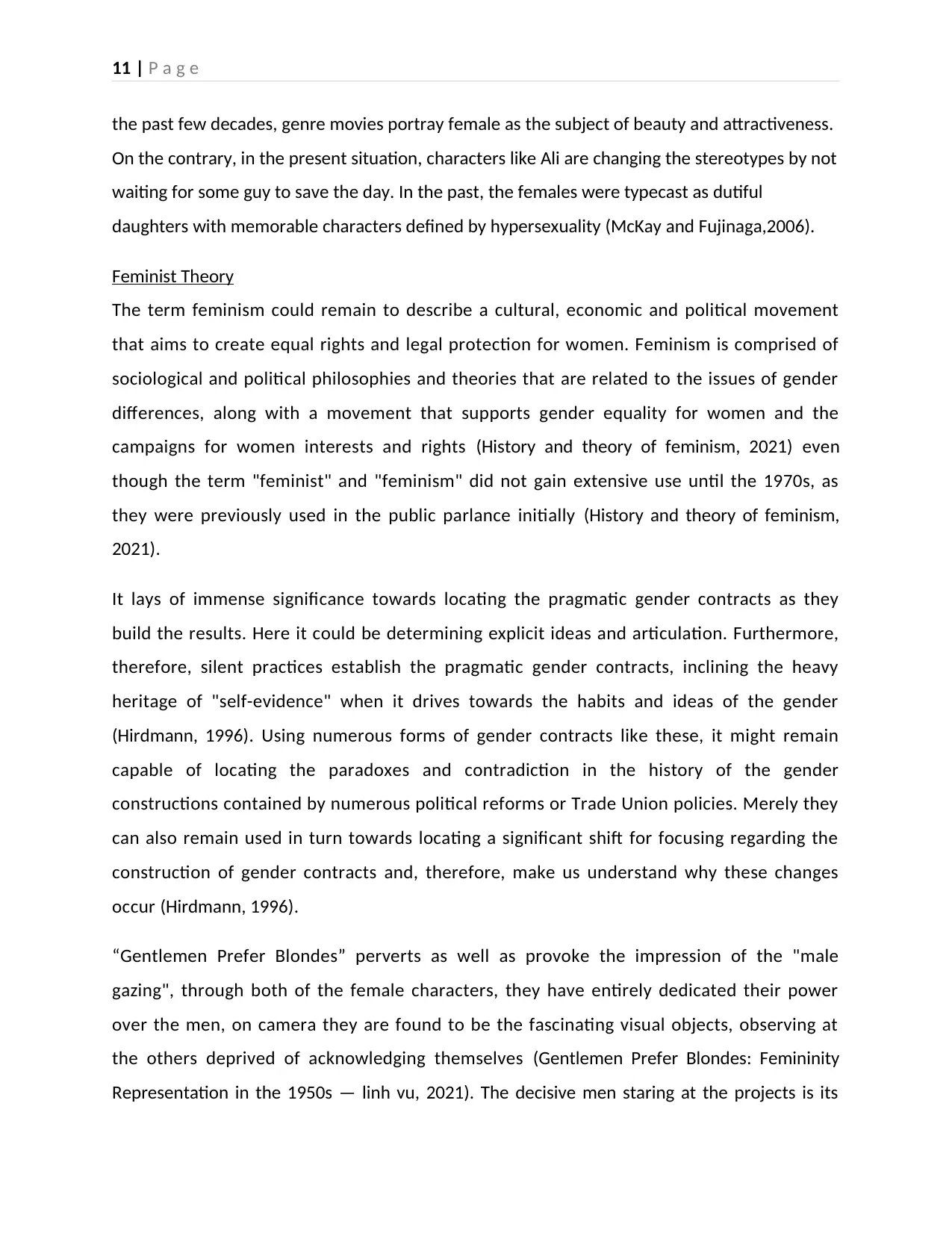
11 | P a g e
the past few decades, genre movies portray female as the subject of beauty and attractiveness.
On the contrary, in the present situation, characters like Ali are changing the stereotypes by not
waiting for some guy to save the day. In the past, the females were typecast as dutiful
daughters with memorable characters defined by hypersexuality (McKay and Fujinaga,2006).
Feminist Theory
The term feminism could remain to describe a cultural, economic and political movement
that aims to create equal rights and legal protection for women. Feminism is comprised of
sociological and political philosophies and theories that are related to the issues of gender
differences, along with a movement that supports gender equality for women and the
campaigns for women interests and rights (History and theory of feminism, 2021) even
though the term "feminist" and "feminism" did not gain extensive use until the 1970s, as
they were previously used in the public parlance initially (History and theory of feminism,
2021).
It lays of immense significance towards locating the pragmatic gender contracts as they
build the results. Here it could be determining explicit ideas and articulation. Furthermore,
therefore, silent practices establish the pragmatic gender contracts, inclining the heavy
heritage of "self-evidence" when it drives towards the habits and ideas of the gender
(Hirdmann, 1996). Using numerous forms of gender contracts like these, it might remain
capable of locating the paradoxes and contradiction in the history of the gender
constructions contained by numerous political reforms or Trade Union policies. Merely they
can also remain used in turn towards locating a significant shift for focusing regarding the
construction of gender contracts and, therefore, make us understand why these changes
occur (Hirdmann, 1996).
“Gentlemen Prefer Blondes” perverts as well as provoke the impression of the "male
gazing", through both of the female characters, they have entirely dedicated their power
over the men, on camera they are found to be the fascinating visual objects, observing at
the others deprived of acknowledging themselves (Gentlemen Prefer Blondes: Femininity
Representation in the 1950s — linh vu, 2021). The decisive men staring at the projects is its
the past few decades, genre movies portray female as the subject of beauty and attractiveness.
On the contrary, in the present situation, characters like Ali are changing the stereotypes by not
waiting for some guy to save the day. In the past, the females were typecast as dutiful
daughters with memorable characters defined by hypersexuality (McKay and Fujinaga,2006).
Feminist Theory
The term feminism could remain to describe a cultural, economic and political movement
that aims to create equal rights and legal protection for women. Feminism is comprised of
sociological and political philosophies and theories that are related to the issues of gender
differences, along with a movement that supports gender equality for women and the
campaigns for women interests and rights (History and theory of feminism, 2021) even
though the term "feminist" and "feminism" did not gain extensive use until the 1970s, as
they were previously used in the public parlance initially (History and theory of feminism,
2021).
It lays of immense significance towards locating the pragmatic gender contracts as they
build the results. Here it could be determining explicit ideas and articulation. Furthermore,
therefore, silent practices establish the pragmatic gender contracts, inclining the heavy
heritage of "self-evidence" when it drives towards the habits and ideas of the gender
(Hirdmann, 1996). Using numerous forms of gender contracts like these, it might remain
capable of locating the paradoxes and contradiction in the history of the gender
constructions contained by numerous political reforms or Trade Union policies. Merely they
can also remain used in turn towards locating a significant shift for focusing regarding the
construction of gender contracts and, therefore, make us understand why these changes
occur (Hirdmann, 1996).
“Gentlemen Prefer Blondes” perverts as well as provoke the impression of the "male
gazing", through both of the female characters, they have entirely dedicated their power
over the men, on camera they are found to be the fascinating visual objects, observing at
the others deprived of acknowledging themselves (Gentlemen Prefer Blondes: Femininity
Representation in the 1950s — linh vu, 2021). The decisive men staring at the projects is its
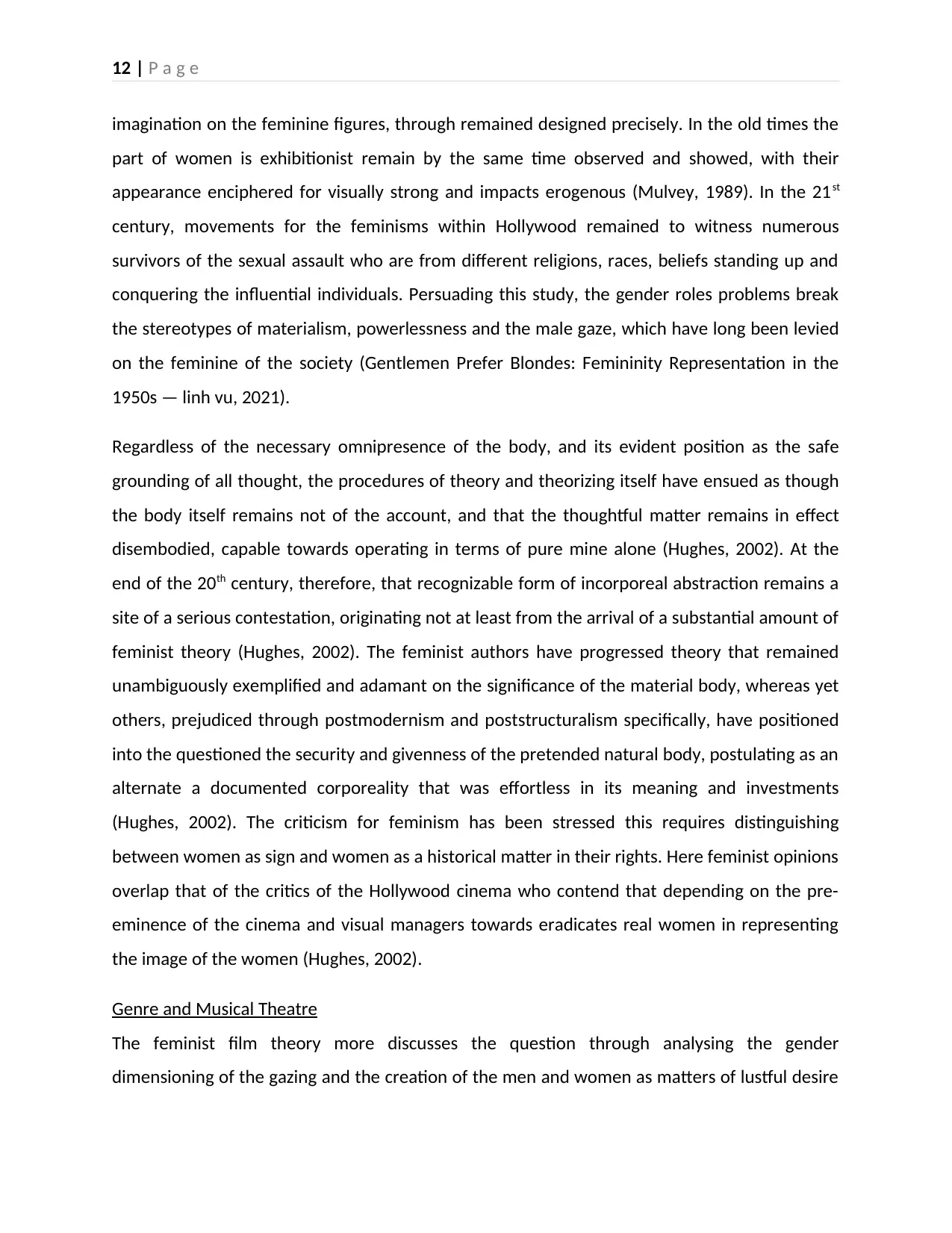
12 | P a g e
imagination on the feminine figures, through remained designed precisely. In the old times the
part of women is exhibitionist remain by the same time observed and showed, with their
appearance enciphered for visually strong and impacts erogenous (Mulvey, 1989). In the 21st
century, movements for the feminisms within Hollywood remained to witness numerous
survivors of the sexual assault who are from different religions, races, beliefs standing up and
conquering the influential individuals. Persuading this study, the gender roles problems break
the stereotypes of materialism, powerlessness and the male gaze, which have long been levied
on the feminine of the society (Gentlemen Prefer Blondes: Femininity Representation in the
1950s — linh vu, 2021).
Regardless of the necessary omnipresence of the body, and its evident position as the safe
grounding of all thought, the procedures of theory and theorizing itself have ensued as though
the body itself remains not of the account, and that the thoughtful matter remains in effect
disembodied, capable towards operating in terms of pure mine alone (Hughes, 2002). At the
end of the 20th century, therefore, that recognizable form of incorporeal abstraction remains a
site of a serious contestation, originating not at least from the arrival of a substantial amount of
feminist theory (Hughes, 2002). The feminist authors have progressed theory that remained
unambiguously exemplified and adamant on the significance of the material body, whereas yet
others, prejudiced through postmodernism and poststructuralism specifically, have positioned
into the questioned the security and givenness of the pretended natural body, postulating as an
alternate a documented corporeality that was effortless in its meaning and investments
(Hughes, 2002). The criticism for feminism has been stressed this requires distinguishing
between women as sign and women as a historical matter in their rights. Here feminist opinions
overlap that of the critics of the Hollywood cinema who contend that depending on the pre-
eminence of the cinema and visual managers towards eradicates real women in representing
the image of the women (Hughes, 2002).
Genre and Musical Theatre
The feminist film theory more discusses the question through analysing the gender
dimensioning of the gazing and the creation of the men and women as matters of lustful desire
imagination on the feminine figures, through remained designed precisely. In the old times the
part of women is exhibitionist remain by the same time observed and showed, with their
appearance enciphered for visually strong and impacts erogenous (Mulvey, 1989). In the 21st
century, movements for the feminisms within Hollywood remained to witness numerous
survivors of the sexual assault who are from different religions, races, beliefs standing up and
conquering the influential individuals. Persuading this study, the gender roles problems break
the stereotypes of materialism, powerlessness and the male gaze, which have long been levied
on the feminine of the society (Gentlemen Prefer Blondes: Femininity Representation in the
1950s — linh vu, 2021).
Regardless of the necessary omnipresence of the body, and its evident position as the safe
grounding of all thought, the procedures of theory and theorizing itself have ensued as though
the body itself remains not of the account, and that the thoughtful matter remains in effect
disembodied, capable towards operating in terms of pure mine alone (Hughes, 2002). At the
end of the 20th century, therefore, that recognizable form of incorporeal abstraction remains a
site of a serious contestation, originating not at least from the arrival of a substantial amount of
feminist theory (Hughes, 2002). The feminist authors have progressed theory that remained
unambiguously exemplified and adamant on the significance of the material body, whereas yet
others, prejudiced through postmodernism and poststructuralism specifically, have positioned
into the questioned the security and givenness of the pretended natural body, postulating as an
alternate a documented corporeality that was effortless in its meaning and investments
(Hughes, 2002). The criticism for feminism has been stressed this requires distinguishing
between women as sign and women as a historical matter in their rights. Here feminist opinions
overlap that of the critics of the Hollywood cinema who contend that depending on the pre-
eminence of the cinema and visual managers towards eradicates real women in representing
the image of the women (Hughes, 2002).
Genre and Musical Theatre
The feminist film theory more discusses the question through analysing the gender
dimensioning of the gazing and the creation of the men and women as matters of lustful desire
⊘ This is a preview!⊘
Do you want full access?
Subscribe today to unlock all pages.

Trusted by 1+ million students worldwide
1 out of 21
Your All-in-One AI-Powered Toolkit for Academic Success.
+13062052269
info@desklib.com
Available 24*7 on WhatsApp / Email
![[object Object]](/_next/static/media/star-bottom.7253800d.svg)
Unlock your academic potential
Copyright © 2020–2025 A2Z Services. All Rights Reserved. Developed and managed by ZUCOL.